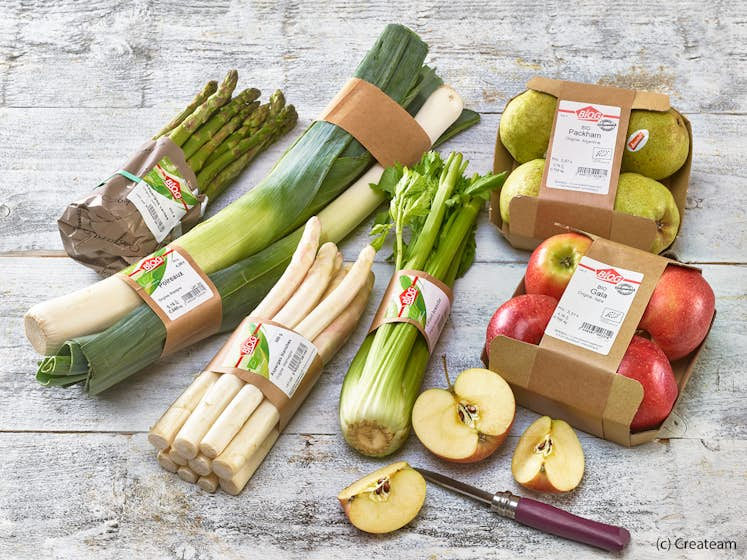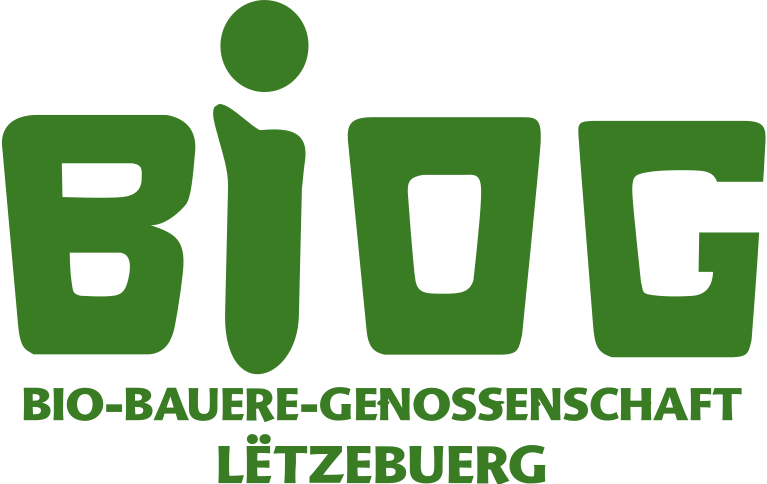Packaging
Packaging can be a heavy burden on our environment. In fact, not only does it consume valuable resources in its manufacture, but it often also pollutes the water, the soil and the air. It would therefore be preferable to do away with packaging altogether. Unfortunately, that’s impossible for many foods. Packaging simplifies the transportation of the products, protects them, and means they can be kept for longer. It also allows for clear labelling, for example, to indicate whether it is an organic product or an item produced in a conventional manner.

Lost or reusable packaging?
Lost or reusable packaging?
Reusable packaging presents not insignificant advantages: it can be used several times and conserves resources. If transport and technical possibilities allow, reusable packaging is preferable. Returnable glass bottles, for example, are the best choice for our BIOG juices, like the organic apple juice and organic orange juice. No other packaging preserves the unique flavour of the juices in the same way as the returnable glass bottles. In fact, glass has the advantage of being chemically inert. There is therefore no risk of migration, by which we mean the passage of chemical components from the packaging material to the food.
From an ecological point of view, however, glass is not always the most attractive solution. Empty bottles – like other reusable packaging – need to be collected and cleaned, which requires special rinsing systems. Their weight and volume can also have a negative impact on the energy consumed in transportation, particularly where this involves long distances between the washing station and the store. What’s more, the caps cannot be reused immediately, but must be collected separately, then undergo energy-hungry recycling.
An alternative to glass may, therefore, be packaging made from composite material, which we use for BIOG milk, among other things. From an ecological point of view, this type of packaging behaves relatively well because it is very light and easy to transport. The cardboard used in this type of packaging is Forest Stewardship Council (FSC) certified and can be recycled almost in its entirety.
Cellulose instead of plastic
Cellulose instead of plastic
A breakthrough on the way to more sustainable packaging is the introduction of the proven 100% biologically recyclable cellulose-based packaging for fruit and vegetables in 2021. The plastic-free material is certified by TüV Rheinland as "home and garden compostable" - currently the highest environmental standard for film packaging worldwide - and is therefore suitable for disposal in the organic waste bin and in home/garden compost. The film dissolves into its original natural components during composting, thus remaining part of a natural circular economy and conserving resources and the environment.
The cellulose film replaces the film for those BIOG products that were previously packaged in PLA film. Incidentally, the nets used, e.g. for mandarins and lemons, have already been made of cellulose for about 5 years.
Organically sourced plastics
Organically sourced plastics
Since 2008 the wholesaler BIOGROS started to use biodegradable bioplastics (PLA) to package fruit and vegetables. At the time, many experts considered this new type of packaging to be a significant ecological improvement. Up to that point, BIOGROS had been using exclusively petroleum-based plastic, for want of other solutions. The bioplastics used by BIOGROS are based on cornstarch, a renewable raw material. This packaging is biodegradable, compliant with European standard DIN EN 13432 and, in certain conditions, it decomposes to be generally converted into CO2 and water, so that it doesn’t stay indefinitely in the seas and soils.
However, one of the problems of this type of packaging is that, in terms of cultivated area, its production may enter into competition with food production.
In comparison, the cellulose-based packaging film represents a significant improvement in terms of raw materials and compostability.
Packaging paper
Packaging paper
Natural and plastic-free, packaging paper is appreciated by customers who respect the environment. It has the advantage of coming from renewable raw materials and being easy to use and recycle. Moreover, pure paper decomposes rapidly with the help of organisms present in the soil and bacteria and, unlike many other packaging materials, it does not leave any trace in the environment. However, in practice, pure paper is often not sufficient for packaging foods when, for example, the packaging needs to conserve flavour, or prevent humidity from penetrating or fat from escaping. In those cases, the paper is also covered with plastic film. That means it must not be thrown away with old papers, but with non-recyclable waste. What’s more, recycled paper is difficult to use for packaging foods because it can become contaminated, among other things, by residues from the mineral oil contained in the inks. Food packaging paper is therefore principally composed of new wood fibres, hence the growing demand for wood throughout the world.
Despite all these problems, for us, paper remains a preferred packaging material because its advantages generally outweigh those of other materials. For example, most of the BIOG dairy produce packaging is made from paper. Paper packaging is also used for the BIOG flour and cereals. Since spring 2019, certain fruits and vegetables have been packaged in stiff paper or paper banderole wraps. BIOGROS has purchased a new packaging machine specially designed for this purpose. We also ensure we use Forest Stewardship Council (FSC) certified paper from sustainable sources.
Is plastic always bad?
Is plastic always bad?
Even if it may seem surprising at first glance, normal plastic is not always the worst choice from an ecological point of view. The use of plastic often allows us to save on packaging materials, which has a positive effect on the use of resources and on the carbon footprint during the transportation of the products. Added to that, certain types of plastic can be recycled very effectively, for example polyethylene terephthalate (PET). Contrary to many views, plastic food packaging does not always contain plasticisers: packaging made from polyethylene (PE) and polypropylene (PP), for example, doesn’t need them. Packaging made from a single type of plastic is generally easy to recycle. This packaging is therefore preferable, as is packaging that already contains recycled plastic and therefore contributes to the conservation of resources. The packaging for BIOG charcuterie and cheese, for example, meets this description.
On the other hand, plastic is a problem when its use is disproportionate, if it cannot be recycled and if it ends up in the environment.
Our companies and packaging materials
Our companies and packaging materials
Deciding on the best packaging material is no easy matter. We must make a decision for each product, by comparing the advantages and disadvantages. What’s more, we are bound by the technical equipment of each of our producers and we also depend on manufacturers of packaging materials, who use their expertise to develop new solutions and constantly improve them.
As purely manual packaging is unaffordable these days, our choice is also influenced by the packaging system available within the company. So it is not always possible to switch to innovative and more eco-friendly packaging. After all, the machines cannot be continually replaced or adapted to the packaging. Also, it does not make sense to get rid of packaging that is already printed, in order to switch to a more eco-friendly version. First of all, we need to exhaust existing stocks, which allows us to conserve resources.
For us, the road to constant improvement of BIOG packaging consists of ceaselessly seeking innovative solutions and satisfying ourselves of their feasibility. In addition, we strive to reduce the use of packaging materials wherever possible.
Avoiding food waste
Avoiding food waste
In some cases, sustainable packaging is even more environmentally friendly than leaving it out. For example, it is a lever in the fight against food waste, as the wrapping material protects sensitive products and allows for an extended shelf life. In addition, products of organic and biodynamic origin meet stricter quality criteria than their conventional counterparts, which can be communicated thanks to the information made visible on the packaging. This is particularly important in mixed retail. In this way, the consumer can be sure "where organic is metiond on the outside, there's organic inside".
